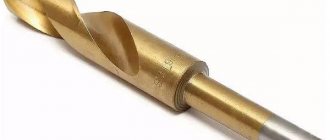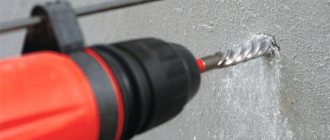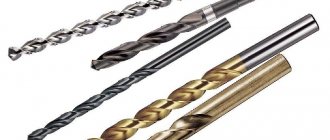From the author: Hello friends! To carry out repair and construction work, it is often necessary to drill into concrete and brick walls. Drills for metal surfaces are not suitable; they quickly begin to become dull and differ in the cutting part, quality and other features. Therefore, you need to know which drill bits for concrete are best, because there are quite a large number of their manufacturers.
Main types of concrete drills
A distinctive feature of a concrete drill from others is soldering. It is created from a strong alloy, due to which a hardness similar to diamond stones is achieved. Craftsmen call these types pobedit; these products differ in strength from other types that are created for metal or wood.
There are 2 main types by which concrete drills are classified:
- for a drill - consist of a shank for a nozzle, which is made in a cylindrical or multifaceted shape. The dimensions are small, the product is suitable for creating holes in many hard materials, for example, brick, foam block. It is recommended to use a high-power drill, which will allow you to drill into concrete,
- for a hammer drill - the drill is cylindrical in shape, has a shank, designations SDS PLUS or SDS MAX. The goods themselves are quite large and long, suitable for reinforced concrete structures.
If you need to create holes in a reinforced concrete structure using a simple drill, then it is not always possible to solve the problem with just a drill. You need to use a hammer drill, and for this tool, drills are divided into the following types:
- screw - used to create deep holes,
- spiral - suitable for large holes,
- flat - used for drilling passages of different sizes and depths.
For proper operation, you will need to not just insert the drill into the chuck, but snap it into place. To make this task easier, the products have a slight thickening at the very end. It should also be noted that the products are considered professional tools, since they can be used to create holes from 4 mm to 3 cm in diameter.
If you need a larger hole, then the crown type will come to the rescue. Such products make it possible to make a recess of 12 cm in diameter. The products are very durable and are produced in several versions:
- diamond - visually made in the form of a pipe or crown, mounted on a rod, the edges are coated with diamond, which ensures high strength,
- pobedit - similar to an attachment, the main difference from diamond is the absence of sputtering; it is replaced by special teeth made from pobedit.
It is recommended to use crown products for holes for sockets, switches or wiring, and other communications. To select a suitable concrete product for a drill, you will need to take into account not only the parameters of the element, but also the dimensions of the future hole. Based on this, the length of the drill is selected, which depends on the diameter:
- diameter 4 mm - length 5 cm,
- 5 mm - 10 cm,
- 6 mm - 15 cm,
- 8 mm - 25 cm,
- 10 mm - 54 cm,
- 12 mm or more - up to 100 cm.
It turns out that for large holes a long concrete drill is used. If you use thin instruments, there is a risk of damage due to increased load.
What it is?
- Concrete drills are equipped with special brazing tips made from high-strength pobedite alloy, which is almost as hard as diamond.
- The pobedite tip, welded to the top of the drill, is an alloy of tungsten and cobalt with other chemical elements added .
- The strength of such products allows them to be successfully used when drilling structures made of hard materials.
Distinctive features
In order to determine when looking at a drill for concrete that this is exactly the option that is needed for working with high-strength structures, you should know its main features.
Tip type:
- wood drills have a sharp tip, which, when used, penetrates the surface of the material;
- products for drilling metal have a cone-shaped tip;
- Concrete drills are blunted at the end and equipped with a lamellar brazing made of Pobedit.
By color:
- black metallic color is typical for metal drills;
- products for drilling wood have a lighter metallic shade;
- white color is a sign of a concrete drill.
Kinds
- Drills for drilling concrete can be roughly classified based on two parameters: the diameter of the holes being drilled and the type of tool used.
- To make small-diameter holes, it is possible to use both impact drills and hammer drills, into which drills with T-shaped or cross-shaped tips are installed.
- Making large holes in concrete is done using diamond bits shaped like a cylinder.
Do you know how to properly tap a wall for wiring? Detailed instructions here.
Drill types:
- The most common type is products that are similar in shape and size to ordinary drills, but equipped with pobedite surfacing at the end.
- Another option is a drill bit . Such a tool can be designed to work with a drill or hammer drill. The drill with which the drill is equipped is equipped with a cylinder-shaped shank that allows it to be fixed in a jaw chuck.
- Drills for rotary hammers (marked SDS) are equipped with shanks with longitudinal grooves, due to which the drill is securely attached to a snap-on chuck. The thickness of the drill for an impact drill does not exceed 12 mm; hammer drill products can have a diameter of up to 3 cm, and make holes up to 1 m deep.
- Diamond core bits are used for larger holes (for example, when installing socket boxes or laying a pipeline). The crown consists of a steel cylinder and a rod attached to it (see photo), which is inserted into the chuck of a hammer drill or a special installation. Using the crown is quite convenient and simple.
Which ones are better to choose?
First of all, you should decide on the following criteria:
- depth and diameter of the proposed holes;
- the type of drilling tool used.
You should not give preference to cheap options, since drilling concrete strongholds requires the use of high-quality products.
It is better to opt for well-known foreign (Bosh, Metabo, Makita) or domestic (Zubr, Enkor, Interskol) manufacturers.
How to drill a concrete wall in an apartment?
If you need to drill holes less than 13 mm wide, you can use a conventional drill. To drill a larger hole, you will need a hammer drill.
The presence of an impact function increases the productivity of this tool, and the special design of the chuck, which allows you to quickly change the drill, makes it possible to reduce the time required to complete the job.
If you don’t have a hammer drill at hand, and the quality of the impact drill leaves much to be desired, then for drilling concrete walls it is better to use a carbide drill with asymmetric sharpening.
If you are thinking about whether it is possible to drill concrete with a screwdriver, then you should understand that not every model is suitable for such purposes. Here you will need a unit with the same hammer drill function, with a power of at least 1 kW.
But in any case, such a tool can hardly be used to perform any large-scale work.
How to drill through concrete with reinforcement?
The main part of the work on drilling reinforced concrete structures is performed using concrete drills. The drill is inserted into the drill (hammer) at a right angle, making sure that it fits into the chuck all the way.
If you hit the reinforcement during the drilling process, you can use special punches (if a hammer drill is involved in the work), which will help overcome the iron barrier . When using a drill to drill reinforcement, a simple metal drill will do.
During the work, the plaster on the other side of the wall may fall off . To avoid this phenomenon, you should set the tool to lower speeds.
If for some reason the drill gets stuck in the thickness of the wall, you should not try to pull it out by loosening the drill, as it can easily break .
article on how to properly lay tiles on walls.
As a result, the broken end will remain inside the wall. It is best to take a drill of a smaller diameter , with which you can drill out a stuck tool.
If drilling is performed with a non-professional tool, you should not use it for more than a quarter of an hour, taking a break for about the same period of time. Before resuming work, the drill should be moistened with water.
- Compliance with the above rules and instructions will allow you to avoid possible problems and save energy and nerve cells during drilling of a reinforced concrete stronghold.
- Watch the following video on how to drill through concrete:
Source: https://moistenki.ru/otdelka-vnutri/sverlo-po-betonu-dlya-dreli.html
Features of drills
In order to choose the right drill for concrete structures, without making mistakes, you will need to know the features that distinguish them from products for metal and other materials.
The shape of the working area will be quite blunt; this area is made of a Pobedit plate. This type is suitable for concrete as woodworking products will include sharp tips. Due to this, at the beginning of the work, the wood is stuck inside, and only then a hole is made. The working area of a metal product is similar to a cone with no sharp points.
The color of concrete products is often metallic white. Products for wood will be strictly metal, and for metal, black colors are used.
Drilling Tips
There are a few simple rules to follow when drilling into concrete. Due to this, the work is performed more efficiently, and the service life of the product increases:
- When you first experience drilling concrete with a drill, you need to prepare several types of drills, you can even reserve them for metal. This is due to the fact that each type has its own purpose - for example, some are suitable for brick, while others are suitable for concrete and ceramics. When creating holes in the wall, there is a possibility that metal reinforcement will appear along the way, in which case the drill is changed and work continues,
- Some people specifically sharpen a concrete drill bit, so they can drill into metal during the job. This decision is wrong, since for the versatility of the product you will need to know many sharpening rules and have a lot of experience,
- It is forbidden to work without breaks; if the drill overheats, it may be damaged. It is recommended to drill for 15 seconds and then leave the drill to cool down. Do not use water or other mixtures for rapid cooling,
- Concrete always contains solid fractions in the form of stones, which can stop the drill during operation. It is easy to crush such inclusions with a chipper, and then continue to create a hole,
- if a hole needs to be made in a concrete wall, which is a load-bearing wall, or in ceilings, then it is better to use a hammer drill. Thanks to it, work is performed more efficiently and quickly,
- It is necessary to drill ceramics on walls or floors without the impact mode of the drill, otherwise the materials will be destroyed. Ceramic surfaces should only be worked with concrete drills,
- Cheap concrete drills are made from low-quality alloy, so they are not hard and need to be sharpened from time to time. To do this, you can use an angle grinder and a diamond disc,
- While drilling, it is not recommended to put pressure on the drill; this causes loss of balance, and drilling becomes more difficult. In addition, there is a possibility of the drill breaking, it simply bursts,
- To make holes for plastic dowels, it is recommended to make the depth a little larger. Dust and other dirt will not allow you to place the element correctly, a reserve is simply necessary,
- You need to start drilling concrete with low drill speeds so that the drill does not jump and the hole is smooth. After reaching a certain depth, the speed increases or the tool switches to impact mode,
- If the drill is used very often and for a long time, then you need to replace the chuck. Over the years, the fixation weakens, so the quality of work decreases, there is a risk of injury,
- When drilling, experts recommend soaking the drill in cold water, but not cooling it using this method. This rule protects the product from damage,
- To maintain cleanliness while working, it is recommended to put a plastic cup on the drill. This protects against flying concrete dust,
- Do not hold or hold the chuck with your hands while the drill is operating. You can only hold on to the body,
- When using gloves and protective clothing, it is important to use the correct size to avoid getting caught in the cartridge. Additionally, it is recommended to wear glasses to protect your eyes from dust.
When working according to the rules and using these tips, drilling concrete will be a simple and safe task, and the drills will last a long time.
How to choose a drill
Before considering the rating, we will mention several key parameters that should be taken into account when choosing drills. Combined with information about the best manufacturers, this will help you choose the best product for your specific needs. Drills are selected paying attention to:
- Suitability for materials
. Products are produced separately for wood, concrete, glass, ceramics and metal. The equipment is not interchangeable, therefore, only drills suitable for it are used for a specific material. - Color.
The tool is made of high-speed tool steel, which has a silver color. This is the cheapest, but short-lived option. Black drill bits are steam hardened and keep their cutting edge sharp longer. The bright gold ones are coated on the outside with titanium nitride, which reduces friction and increases strength. The pale gold ones were hardened, but the internal stress was removed, eliminating the brittleness. - View of the cutting part
. The edge is sharpened at a different angle, depending on the diameter of the drill, and can be triangular (spiral) or with a centering rod (trident). The latter is necessary for quick drilling without punching. Drills with crowns help create a large-diameter hole for inserting a lock, etc. Pen tips are used for wood and fast passage of thicknesses of 5-15 mm. Diamond ones are applied to a tubular base and are suitable for glass and tiles. - Labeling.
There is a marking on the shank indicating what the drill is made of. HSS refers to conventional high speed steel. Prefixes in the E, Co, TiN index indicate various additives in the form of cobalt, titanium, etc., which increases strength and resistance to overheating. The CV specifies chrome vanadium steel. - Type of working part.
The body of the drill can be cylindrical in the form of a spiral (for creating through holes), conical (for deepening or quickly drilling shallow holes of different diameters), stepped (instant transitions to different hole diameters when drilling sheet steel without changing equipment). - Shank
. The cylindrical type is suitable for hand drills and screwdrivers. Conical is used only for machine tools. Cylindrical with grooves, suitable for installation in hammer drills with SDS-Plus and SDS-Max chucks. The hexagon is inserted into a screwdriver with a similar chuck instead of a bit. The three-edged cylinder is clamped by the three-blade drill chuck and prevents rotation when resisted against viscous material. - Diameter
_ Drills with diameters from 1.0 to 55 mm are produced. The equipment can only be inserted into an electric drill chuck with an indicator of 13 mm; all the rest are suitable for machine tools. The diameter is selected taking into account the future hole that needs to be obtained. When drilling 10 mm in size, the finished hole will be 11 mm, because 1 mm is “eaten up” due to active rotation. - Length
_ Selected depending on the required hole depth. The indicator varies from 3 to 90 cm.
Sharpening
When drilling concrete surfaces, sooner or later there is a need to sharpen the working part, even if it is made of diamond or coated with diamond. For the procedure you will need to use a sharpener or a special machine. In addition, at home you can use a regular universal machine or sharpen attachments with a grinder.
It is important to inspect the drill tip before doing any work. It should have 2 “shelves” that are the same length. Otherwise, damage will occur during drilling, and the holes themselves will be of poor quality. The whole sharpening process is not complicated, the main thing is to ensure the evenness of the shelves:
- for concrete and other hard materials, the alpha angle is 200–300,
- the cutting edges must not touch the grinding wheel, otherwise there is a risk of breakage,
- When sharpening, it is forbidden to bring the drills to heat; from time to time you need to pause and cool the material; the use of water is allowed. If the working part is hot, then it must be left to cool in the usual way, since contact with water risks cracking the drill.
Sharpening a drill for concrete is a complex process that requires certain skills, so without knowledge it is better to turn to the experts.
Review of manufacturers
Drills that are used for concrete are produced by both domestic and foreign companies. The cost largely depends on the country of origin. The high price of the product is justified, since all types of concrete products are characterized by a long service life and improved quality. It is very difficult to say exactly which is the best concrete drill bit for a drill. Among the leaders from foreign brands are:
- Makita - precision drills with unusual brazing. While working, it is easy to create smooth and clear holes of different sizes, but more often they are shallow,
- Bosch is the most popular company producing equipment and materials for repairs and construction. The drills have a four-spiral working surface. This ensures maximum performance and minimum friction. Often used for drilling concrete of any density and creating deep holes,
- Diager Twister is a company that is distinguished by its high reliability and high-quality product. Drills are used for both concrete, brick, and other stones. The assortment is very large, there are drills for drills, hammer drills and other tools,
- Metabo and Staver .
The companies described produce high-quality products, but they are expensive. Among domestic companies and manufacturers from the CIS and China, it is necessary to highlight:
- Bison are the most common drills from domestic manufacturers. The company offers a large assortment at an affordable price with good quality,
- Interskol,
- Anchor,
- Hurricane.
Chinese drills can be quite good and reliable, but they cost more than usual. It is worth understanding that high-quality goods cannot be cheap, since only the best raw materials and new technologies are used for their production. To make the right choice, it is recommended to watch the video:
Products with low cost may be made from a poor alloy, or made in violation of the technological process. There are many fakes that are almost no different from the original. Craftsmen claim that a fake is always darker in color, since some of the stages during casting are skipped or disrupted. To save money, it is better to buy drills in a set rather than individually.
The best wood drills
Wood differs from metals in having lower density and tensile strength. Parts made of this material can be thick. Manufacturers of equipment intended for furniture makers and builders take this into account. For drilling, you can buy a long wood drill, or opt for a feather, spiral or screw tool. Our team recommends three brands of tools that are characterized by increased service life, good efficiency when processing wet and dry wood, and wear resistance.
Fit 36429
A model with a countersink, intended for furniture workshop craftsmen. With its help, you can make a hole for a standard confirm screw, 5x50 mm in size. Used in conjunction with a depth stop, which is adjusted with a hex wrench included in the kit.
The main drill is made of tool steel and works well with dry wood, chipboard, and plywood. The diameter of the countersink is 6.5 mm, the angle of the cutting edge allows you to quickly and accurately make a hole. Supplied in a blister that reliably protects from dirt.
Advantages:
- Universal cylindrical shank;
- Good quality metal;
- Increased resource;
- Low price;
- Proper sharpening.
Flaws:
- Not detected.
Stayer 2944
A universal wood drill that can replace a set of several tools. Designed to complete an electric drill. It has a “ballerina” type design with the ability to adjust the position of the incisors. Using the equipment, holes with a diameter of 30 to 130 mm are drilled. The position of the cutters is adjusted using the key included in the kit.
The product is made of chrome vanadium steel, which cuts well waterproof plywood, chipboard, dry and wet wood. The sharpening angle of the cutters ensures an even cut at high speed. The shank has a tetrahedral profile and effectively prevents rotation when working with high loads.
Advantages:
- Cheaper than a set of crowns of different diameters;
- Low runout;
- Convenient adjustment;
- Works well with plexiglass;
- Good sharpening.
Flaws:
- Setting up takes a lot of time if you lack experience.
Makita D-07107
A classic spiral model for wood with a centering tip, which allows you to make a hole in a precisely specified location. Made from high-speed steel and highly wear-resistant. The spiral and side cutters are precision ground. The cylindrical shank makes the tool easy to clamp into a three-jaw chuck.
Designed for drilling holes with a diameter of 12 mm. The total length is 155 mm with a working part of 125 mm. Copes well with any types of wood, chipboard, plywood. The sharpening angle makes the hole neat, without visible defects.
Advantages:
- Increased resource;
- Convenient to select the drilling point;
- Can operate at high speeds;
- Does not require additional sharpening.
Flaws:
- High price.











